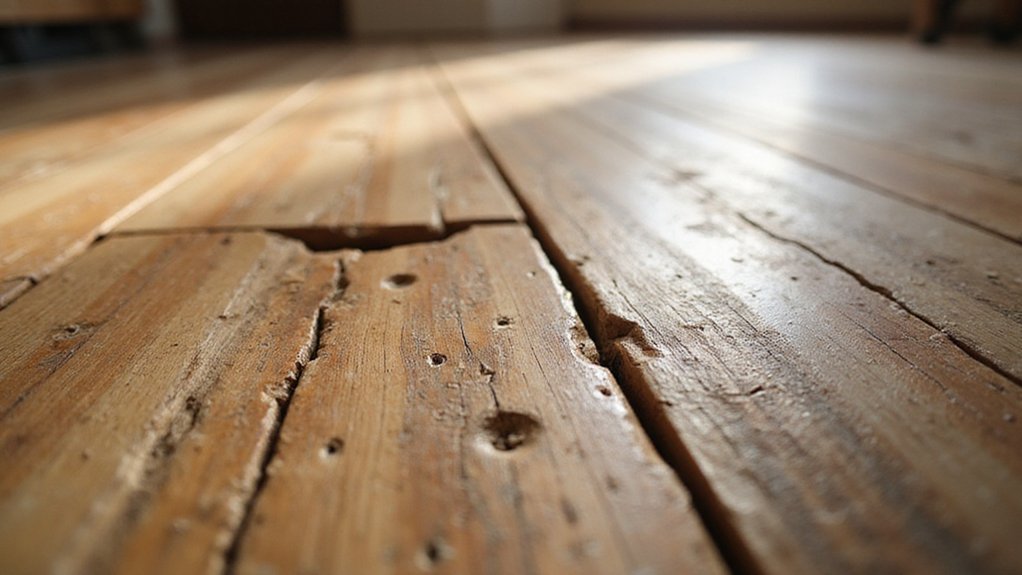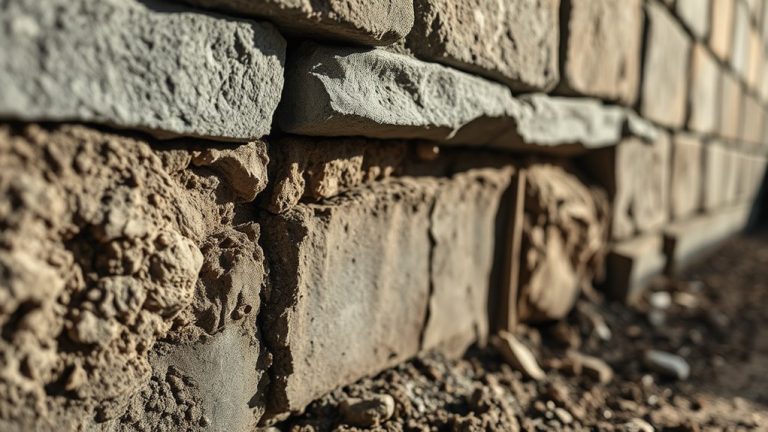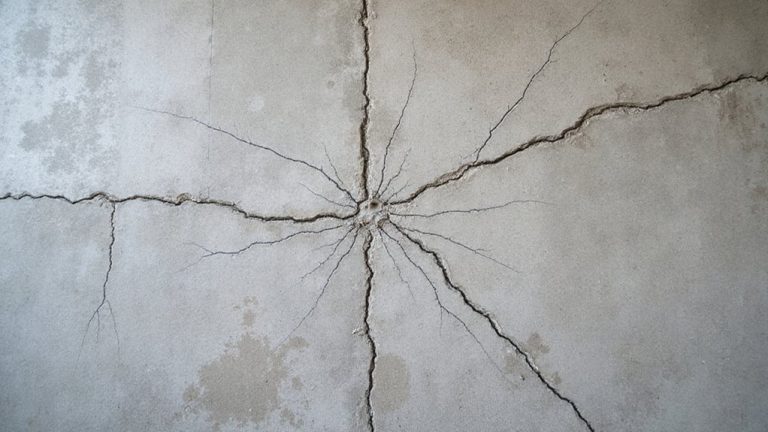Have you ever walked across your home and felt an unsettling wobble beneath your feet? Uneven floors aren't just an aesthetic issue—they're a potential warning sign of serious structural problems. From shifting foundations to hidden water damage, these surface irregularities can indicate deeper challenges that might compromise your home's stability and safety. If you're noticing strange floor dips or hearing unexpected creaks, you'll want to keep reading.
Understanding Foundation Settlement
Foundation settlement is a common issue that can cause your home's floors to become uneven and potentially compromise your property's structural integrity. Poor subsurface drainage and inadequate soil compaction often contribute to this problem, leading to shifts in your home's foundation. Bowing foundation walls can develop from excessive soil pressure and water saturation, indicating a more serious structural concern. When soil beneath your home becomes unstable, it can cause one side of the house to sink or settle unevenly, creating noticeable floor slopes and potential structural damage. Understanding these underlying causes helps you identify and address foundation issues before they become more serious and expensive to repair.
Identifying Water Damage and Moisture Issues
Water damage and moisture can silently wreak havoc on your home's floors, causing uneven surfaces and potential structural challenges. You might notice cracked tiles or a consistently damp basement as early warning signs of underlying moisture problems that can compromise your floor's stability. Foundation drainage solutions can help prevent water from accumulating near your home's structural base and mitigate potential floor damage. These issues often stem from poor drainage, plumbing leaks, or high humidity levels that gradually weaken your home's foundation. When left unchecked, water damage can lead to wood rot, mold growth, and significant structural deterioration. Detecting and addressing these moisture problems early can help prevent costly repairs and maintain your home's integrity.
Soil Conditions and Ground Movement
Ground shifts can quickly turn a level floor into an uneven nightmare for homeowners. Soil compaction and erosion patterns play critical roles in creating foundation problems that compromise your home's structural integrity.
When the ground beneath your house moves unevenly, it can cause significant floor distortion. Clay soils are particularly problematic, expanding and contracting with moisture changes. You'll want to monitor these soil conditions carefully, as they can lead to serious foundation damage.
Professional assessment might be necessary to understand the specific ground movement affecting your home's stability and floor levelness.
Structural Support and Beam Problems
When wooden floor joists or support beams become weakened, they can't effectively distribute your home's weight, leading to noticeable floor unevenness. Damage to load bearing walls can compromise your home's structural integrity, causing floors to sag or slope.
Foundation settlement, wood rot, insect damage, or excessive moisture might weaken these vital support systems. If you're experiencing uneven floors, it's essential to investigate the underlying structural issues. Professional inspectors can assess beam conditions, identify potential problems, and recommend appropriate repairs to restore your home's stability and guarantee your living space remains safe and comfortable.
Signs of Floor Unevenness to Watch For
Homeowners can quickly spot signs of floor unevenness by paying attention to subtle changes in their living spaces. Sagging floors and squeaking floorboards are clear indicators that something might be wrong with your home's structural integrity.
You'll notice doors that don't close properly, visible dips or slopes when walking across rooms, and furniture that seems slightly tilted. Uneven floors can also create gaps between baseboards and flooring, or cause ceramic tiles to crack. If you're experiencing these symptoms, it's time to investigate the underlying causes and consider professional assessment to prevent further damage.
Professional Assessment and Diagnostic Techniques
After noticing uneven floor symptoms, professional assessment becomes a crucial next step in understanding and resolving structural problems. Experts use visual inspection techniques and advanced diagnostic tools to pinpoint the root cause of floor unevenness. They'll carefully examine your home's foundation, supporting structures, and potential damage indicators.
Key diagnostic methods include:
- Laser level measurements revealing precise floor elevation changes
- Thermal imaging to detect hidden moisture issues
- Structural engineer evaluations for thorough analysis
- Digital floor scanning technology
- Foundation stress point assessments
Professional diagnosis guarantees you'll comprehend your floor's specific challenges and receive focused repair recommendations.
Repair Methods for Different Floor Types
Every home's flooring demands a unique repair approach depending on its material composition and underlying structural conditions.
For wooden floors, you'll want to address minor unevenness through careful sanding or using self-leveling compounds. Concrete floors might require grinding or specialized patching techniques. Tile floors often need strategic re-grouting or complete section replacement to restore evenness.
While some repair DIY projects can be manageable, complex floor issues typically call for professional floor refinishing. Choosing the right method depends on your floor's specific material, damage extent, and your comfort with home repair techniques.
Cost-Effective Solutions and Prevention Strategies
Three key strategies can help homeowners manage uneven floor issues without breaking the bank. By focusing on budget-friendly options and long-term maintenance, you can protect your home's structural integrity and save money.
Key prevention and cost-effective solutions include:
- Regularly inspect foundation and floor joists
- Address moisture issues early
- Use affordable self-leveling compounds
- Reinforce weak subfloor areas
- Implement preventative drainage solutions
These strategies not only save you money but also provide peace of mind. By taking proactive steps and understanding potential floor problems, you'll maintain your home's value and comfort while avoiding expensive future repairs.
Frequently Asked Questions
Can Uneven Floors Indicate Serious Structural Problems in My Home?
Uneven floors can signal serious structural issues like poor foundation strength or excessive settling. You'll want to get a professional inspection to prevent potential damage and safeguard your home's stability.
How Quickly Do Uneven Floors Worsen if Left Untreated?
If you don't address floor settling quickly, instability factors can accelerate uneven floor progression, potentially causing significant structural damage within months to a few years, depending on underlying conditions.
Do DIY Floor Leveling Techniques Actually Work for Permanent Solutions?
DIY self-leveling compounds can provide temporary relief, but you'll likely need professional floor leveling for a truly permanent solution. Your home deserves expert care to guarantee long-lasting, stable flooring.
Will Homeowners Insurance Cover Repairs for Uneven or Sagging Floors?
Your coverage depends on policy requirements and a professional structural integrity evaluation. If the damage stems from sudden, accidental events, you'll likely have financial support for your uneven floor repairs.
Can Floor Unevenness Cause Additional Damage to My Home's Structure?
You'll find that uneven floors can definitely compromise your home's structural integrity, causing serious soil erosion impact and foundation movement concerns that may lead to widespread damage if left unchecked.



